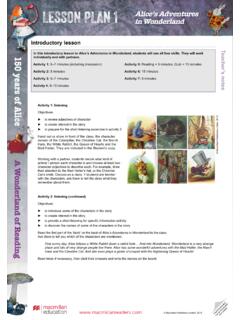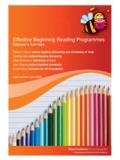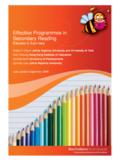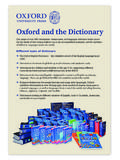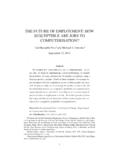Transcription of Effective Reading - Macmillan Readers – English …
1 Series Editor Scott MilesReadingEffectiveTeacher s File3 IntermediateScott MilesMacmillan Education Between Towns Road, oxford OX4 3PP A division of Macmillan Publishers Limited Companies and representatives throughout the worldISBN: 978-0-230-02918-7 Text Scott Miles 2010 Design and illustration Macmillan Publishers Limited 2010 First published 2010 All rights reserved; no part of this publication may be reproduced, stored in a retrieval system, transmitted in any form, or by any means, electronic, mechanical, photocopying, recording, or otherwise, without the prior written permission of the to TeachersPhotocopies may be made, for classroom use, of pages 7 29 (odd-numbered pages only) without the prior written permission of Macmillan Publishers Limited. However, please note that the copyright law, which does not normally permit multiple copying of published material, applies to the rest of this by Jim Evoy and Julian Littlewood, based on an original concept by Designers Collective Illustrated by Ed McLachlanThe authors and publishers are grateful for permission to reprint the following copyright material: Macmillan Publishers Limited for extracts from the Macmillan English Dictionary for Advanced Learners Workbook; dictionary extracts taken from the Macmillan English Dictionary for Advanced Learners.
2 Text Macmillan Publishers we have tried to trace and contact copyright holders before publication, in some cases this has not been possible. If contacted we will be pleased to rectify any errors or omissions at the earliest materials may contain links for third party websites. We have no control over, and are not responsible for, the contents of such third party websites. Please use care when accessing Reading 3 Teacher s FileThis page has been downloaded from Macmillan Publishers Limited 2010. ContentsIntroduction 4. 5 Notes on First texts, Answer keys and Photocopiable activities 6. 291 Personality 62 Punishment 83 Extensive Reading 104 Money 125 Love 146 The internet 167 Language 188 Populations in peril 209 Sports 2210 Overcoming stereotypes 2411 Media 2612 Success 28 Reviews: Answer key 30 Vocabulary review 31.
3 32 Vocabulary review: Answer key 334 Effective Reading 3 Teacher s FileThis page has been downloaded from Macmillan Publishers Limited 2010. IntroductionWelcome to Effective Reading , a four-level Reading course specially designed to meet the needs and interests of students studying English in universities. Effective Reading is different from other course books of its kind in the following principle ways:High interest Reading textsThe main aim of Effective Reading is to provide Reading texts of high interest to university students. Too often course books aimed at an international audience contain content that is either uninteresting or simply irrelevant to students, making it difficult for teachers to keep students engaged in the material. In Effective Reading , all Reading texts have been written specifically to match the interests of young adults.
4 To increase student interest in Reading materials, scholar Anthony Bruton (1997) recommends avoiding (a) general topics with the predictable liberal slant, often communicating nothing that is new; (b) topics of technical or scientific interest to which nothing can be added; (c) culturally distant and anecdotally irrelevant topics; and (d) narratives with a high cultural content. We took this advice to heart when selecting and developing Reading texts in order to maximize student interest, while ensuring that the content is still appropriate for an academic skills developmentEffective Reading teaches Reading skills and strategies to help students become more efficient and successful Readers . Skills such as skimming, scanning and guessing word meanings from context are found in every unit. Effective Reading also promotes the practice of extensive Reading .
5 Information on how to read extensively, as well as extracts from Macmillan Graded Readers , give students the opportunity to discover that Reading in English at their level of difficulty can be an enjoyable way to develop Reading skills, as well as other language vocabulary developmentUniversity students need to be able to read English materials relating to their major, and this requires consolidating their existing knowledge of vocabulary commonly used in academic settings. To reinforce the vocabulary support in Effective Reading books 1 4, the Teacher s Files provide additional vocabulary exercises and tests on words selected from the Academic Word List (a list of words which are common in academic texts).Improving vocabulary knowledge is dependent on good dictionary skills. Using examples from the Macmillan English Dictionary, the Teacher s File provides dictionary skills exercises to increase students familiarity with English - English dictionaries and to help students use them more Reading 3 Teacher s FileThis page has been downloaded from Macmillan Publishers Limited 2010.
6 Overview of Effective Reading books 1 4 Each book is composed of 12 units, with two Reading texts per unit. The format of each unit is as follows:Pre- Reading exercisesThese exercises activate the reader s background knowledge to make the text more accessible, preview key vocabulary and stimulate interest in the Reading textThis is the main Reading text of the unit. The core language (vocabulary and grammar) exercises are drawn primarily from this exercisesThe first post- Reading exercise checks general comprehension of the first Reading text. The second post- Reading exercise highlights specific sentences and expressions from the text, which are typically problematic for learners. Rather than waiting for the teacher to explain or translate the text, this exercise gives students a chance to find the answers on their deveLoPment and sPeaking exercisesThese exercises provide extended work on essential vocabulary and grammar from the first Reading text.
7 Only language items which are common in natural English use are selected, as these are words and structures which students are likely to encounter again and again in their future English study. The speaking exercises give students the chance to reflect on and evaluate the first Reading text, as well as personalize the Reading text and Reading skiLLs workThe second Reading text is shorter and slightly simpler in language than the first Reading text. In this section, students further develop specific Reading skills such as skimming, scanning, Reading speed, guessing word meanings from context, and so Reading 3 Teacher s FileThis page has been downloaded from Macmillan Publishers Limited 2010. Personality1notes on 1st textCulture notes aBo blood types were first discovered in 1901. This discovery is still considered one of the major breakthroughs in medical beliefs in Asia continue to be widely held today.
8 Many women s magazines have regular features on blood-type personality and relationships. Comic book authors usually give their main characters blood types that match their the West, the blood-type diet has recently become relatively popular. This is the theory that blood type is an important factor in determining which foods people should eat. According to the theory, people with blood type O should eat a diet rich in meat, while people with blood type A should eat mainly vegetarian food. People with blood type B may have a more flexible diet and eat a lot of dairy products, while people with blood type AB should eat a combination of foods recommended for blood types A and keyPre- Reading 1 1. link, consequences 2. evidence 3. critics 4. predictions, accuratecomprehension 1 1. F (line numbers 8 12) 2. T (line numbers 17 19) 3.
9 T (line numbers 27 28) 4. T (line numbers 48 51) 5. F (line numbers 56 58) 6. T (line numbers 76 77)comprehension 2 1. b 2. c 3. a 4. a 5. c 6. turns outvocabulary focus 1 1. a 2. d 3. a 4. c 5. c 6. d 7. a 8. cvocabulary focus 2 1. independent 2. optimistic 3. creative 4. stubborn 5. selfish 6. outgoing 7. confident 8. considerate 9. friendly 10. proudgrammar 1 1. Students coming early tomorrow will get bonus The lady working on the contract said she hasn t The man brought in a bag full of Actors in big movies often become very 2 1. My friend has a book signed by Stephen Islam is a religion founded by the Prophet The Lord of the Rings is a film based on a The pyramids in Egypt are huge structures built by thousands of correctionour blood group can shape our future (lines 5 6) personality is related to ABO blood group; scientist (line 7) secondary-school administrator; 1990s (line 9) 1970s; liberal (line 43) conservative; enjoy confrontation (line 46) tend to avoid confrontation; disorganized (line 49) well-organized; considerate (line 19) selfish; easily make close relationships (lines 22 23) close relationships with them difficult; usually finish what they start (lines 34 35) often have trouble finishing what they start; unlikely to divorce (line 34) tend to be uncommitted in relationships.
10 Always sociable (line 59) sociable in some situations; their personality doesn t change often (lines 56 57) contradictory, easily switching from one extreme to the otherPhotocopiable Activity 7 Effective Reading 3 Teacher s FileThis page has been downloaded from It is photocopiable, but all copies must be complete pages. Macmillan Publishers Limited 2010. 1 Personality and language learningThere is no one ideal personality type for learning a language. Every personality type has its own strengths and weaknesses. This activity will help you understand the strengths and weaknesses of your own language-learning personality Read the statements and score them according to the scale (1 5) on the left. Your total score tells you what your learning style Read the following descriptions of learning learners enjoy active learning with others.







